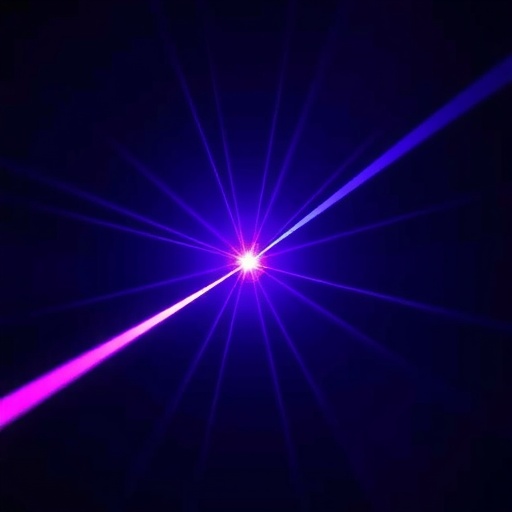In a groundbreaking advancement poised to redefine photonic technology, researchers have successfully demonstrated the generation and sensing of ultraviolet-C (UV-C) laser pulses on femtosecond timescales. This pioneering feat unveils unprecedented opportunities for applications requiring extreme precision in time-resolved spectroscopy, high-resolution lithography, and ultrafast chemical dynamics. UV-C photonics, previously constrained by technological barriers due to the challenging nature of generating and detecting ultrashort pulses in this spectral region, now enters a new era marked by remarkable speed and sensitivity.
The ability to precisely manipulate femtosecond laser pulses in the UV-C region, spanning wavelengths typically between 200 and 280 nanometers, addresses a long-standing gap in photonic research. UV-C light’s high photon energy permits interactions with electronic states that are otherwise inaccessible, enabling novel insights into biological molecules, semiconductor materials, and fundamental physical processes. However, the generation and real-time detection of such rapid bursts of UV-C radiation have historically posed significant challenges, primarily due to the short wavelengths and the limitations of traditional photodetectors.
This breakthrough is achieved through an ingenious integration of advanced nonlinear optical techniques and state-of-the-art ultrafast detection methods. The research team engineered a sophisticated laser system capable of producing laser pulses in the UV-C spectrum with durations on the order of a few femtoseconds—one femtosecond being one quadrillionth of a second. They harnessed high harmonics generation in nonlinear crystals that efficiently convert input infrared pulses into the desired UV-C output while preserving ultrashort durations. This meticulous control over pulse formation marks a monumental stride in laser technology.
Equally remarkable is the team’s development of sensitive photonic sensors that can capture these fleeting UV-C pulses with extraordinary temporal resolution. Traditional electronic detectors, hindered by slower response times and limited spectral sensitivity, are insufficient for this task. Instead, the researchers utilized ultrafast nonlinear optical gating techniques—such as cross-correlation and frequency-resolved optical gating—tailored to UV-C wavelengths. These novel sensing strategies allow for direct characterization of pulse shape, phase, and duration, enabling comprehensive understanding and manipulation of ultrafast UV-C phenomena.
The implications of generating and sensing femtosecond UV-C pulses ripple throughout various scientific and technological disciplines. In chemical physics, the ability to initiate and monitor photoinduced reactions at critical early stages promises to unravel complex reaction mechanisms with unparalleled temporal precision. In biophotonics, ultrafast UV-C pulses could selectively probe nucleic acids and proteins, revealing dynamics essential for understanding radiation damage and molecular conformation changes. The medical field could also benefit through ultrafast laser-based sterilization techniques that maximize microbial destruction while minimizing collateral damage.
Moreover, material sciences stand to gain profoundly as femtosecond UV-C pulses permit exploration of electronic band structure dynamics and defect state evolution in semiconductors and insulators. This capability paves the way for developing novel optoelectronic devices with superior performance and reliability. Additionally, the potential for employing these pulses in precision micromachining and high-resolution nanolithography highlights a transformative leap toward smaller, faster, and more efficient photonic components fabricated with UV-C laser pulses sculpted in femtosecond precision.
Crucially, the researchers have addressed the persistent issue of pulse dispersion and distortion in the UV-C regime, which historically limited the fidelity of ultrashort pulses. By employing innovative dispersion compensation methodologies, including adaptive optical elements and chirped mirrors expressly designed for the UV-C spectrum, the integrity and temporal coherence of the pulses are preserved. This enhancement assures that the pulses interact with target samples or devices exactly as intended, eliminating timing jitter and broadening.
Another noteworthy aspect is the compact and scalable nature of the presented photonic platform. Departing from bulky and immobile setups typical of ultrafast laser labs, the new system integrates components optimized for minimal footprint without compromising performance. This miniaturization opens avenues for deploying femtosecond UV-C photonic technologies outside specialized research facilities, potentially revolutionizing fields such as environmental monitoring, security screening, and industrial process control.
The stability and reproducibility of the generated pulses also represent a significant achievement. The researchers demonstrated long-term operation with negligible drift in pulse parameters, verifying the system’s robustness for practical applications. This reliability boosts confidence in using femtosecond UV-C pulses in routine scientific measurements and industrial workflows, where consistency and precision are paramount.
Interdisciplinary collaboration underpinned this success, bringing together expertise in ultrafast optics, nonlinear photonics, materials science, and sensor engineering. Such collaboration not only facilitated the overcoming of technical obstacles but also fostered a holistic approach for designing, fabricating, and deploying the UV-C laser system. This integrative methodology encapsulates the future of photonic research, where synergistic efforts accelerate innovation.
Looking forward, the research community anticipates rapid expansion of studies exploiting this ultrafast UV-C photonic platform. The capability to control light-matter interaction on femtosecond timescales within the energetically potent UV-C band promises to spawn novel phenomena and transformative technologies. Fundamental investigations into electron dynamics, energy transfer mechanisms, and quantum coherence effects are imminent, powered by the tools the researchers have meticulously crafted.
In conclusion, the successful generation and sensing of ultrashort femtosecond laser pulses in the ultraviolet-C spectrum signify a landmark accomplishment in photonics. This advancement not only conquers longstanding technical challenges but also unlocks vast scientific potential across multiple disciplines. The meticulously developed laser and detection systems embody a fusion of precision, speed, and spectral reach that sets a new standard for ultrafast photonics.
As these technologies transition from laboratory proof-of-concept to widespread application, we may witness revolutionary improvements in data processing speeds, molecular-level imaging, and precision manufacturing. In essence, this breakthrough heralds a new epoch where light manipulation occurs with femtosecond accuracy in one of the most challenging spectral domains, casting a brilliant UV-C glow on the future of science and technology.
Article References:
Dewes, B.T., Klee, T., Cottam, N.D. et al. Fast ultraviolet-C photonics: generating and sensing laser pulses on femtosecond timescales. Light Sci Appl 14, 384 (2025). https://doi.org/10.1038/s41377-025-02042-2
Image Credits: AI Generated
DOI: 19 November 2025
Tags: advanced nonlinear optical techniquesbiological molecule interactionschallenges in UV-C laser generationfemtosecond laser pulseshigh-resolution lithography techniquesphotonic research advancementsprecision in photonic technologysemiconductor material analysistime-resolved spectroscopy applicationsultrafast chemical dynamics researchultrafast detection methodsultraviolet-C laser technology





